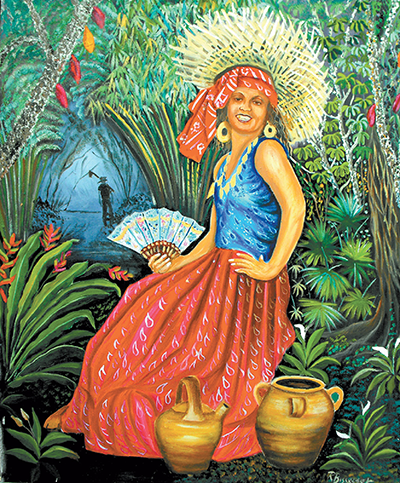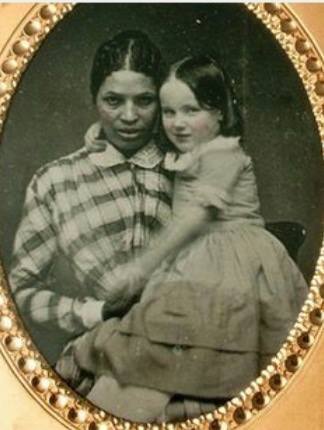 The tale of the La Diablesse originated on the island of Martinique more than three hundred years ago. One has to understand the demonising of the personalities even then and how women were viewed in the Caribbean landscape then and now. Women were viewed as slaves and servants, objects of abuse and the murder of women and instances of severe mutilation were often overlooked by the authorities, especially women of coloured descent. La Diablesse is symbolic of a woman taking a stance against the atrocities of the time. While she was accused of several murders, she stands today in my painting and the writings of my son Angelo Bissessarsingh as being absolved by history and exonerated of her crimes. Her mutilated body is now depicted in disguise and what comes to us is a beautiful smiling coloured woman, not the horrible demon with vampire teeth and fiery eyes. Her image in the Caribbean landscape as a champion of woman’s rights to life and happiness rings through time in Angelo’s writing. —Rudolph Bissessarsingh In the rich pantheon of local folkore, it is the fusion of French and West-African identities which gave us the colourful characters which have danced in the stories of our forefathers, handed down like cherished heirlooms from generation to generation. Earlier this year, I wrote about how the African griot, or storyteller, found new material here in the sugar plantations of the Caribbean where he and his fellows were brutally enslaved. Trinidad was to receive an infusion of French culture from 1783 when Roume de St Laurent (with the support of the Spanish crown) promulgated the Cedula de Poblacion which offered a land grant to Roman Catholic immigrants and their slaves. Hundreds of French planters fleeing the seeds of revolution and their chattels came to the island and created a French colony with Spanish rule, which was later to be replaced by British dominion in 1797. The La Diablesse looms tall in the annals of our mythology. She is the devil woman, the temptress and seductress whose wiles would entrap any man whose ill luck led him into her path. She is both the paragon of womanly beauty and the image of demonic lust. La Diablesse is well known to all who cherish the stories of yesteryear. Almost every village in Trinidad (particularly in the hamlets of the Northern Range) has a yarn to weave about the beautiful woman in the Martiniquan dress—voluminous skirts, head-tie, hat perched jauntily on her head—who waits along the lonely paths for heedless menfolk who would digress from their courses to accommodate a pretty face. Those skirts veil, however, the sinister feature for which La Diablesse is infamous, namely the cloven hoof; the cow-foot which distinguishes her from mortal women. It is largely possible that Martinique was the place of origin of the La Diablesse, since many French settlers came from this island, and the devil woman herself almost always makes an appearance clothed in the style which has become synonymous with the French Antilles. She appears on the nights when the full moon is the only light that pierces the darkness and she waits on those removed byways where a man is likely to pass. The eminent 19th-century traveller and writer Lafcadio Hearn spent two years in the West Indies in the 1880s and though he visited Trinidad, the majority of his stay was in Martinique where he documented several aspects of the French Creole culture. It was Hearn’s memoirs of his West Indian sojourn that introduced La Diablesse to the wider world. In a quarter of the city of St Pierre (which was destroyed with massive loss of life by a volcanic eruption in 1902) he wrote: “Mostly she haunts the mountain roads, winding from plantation to plantation, from hamlet to hamlet. But close to the great towns she sometimes walks: she has been seen at mid-day upon the highway which overlooks the Cemetery of the Anchorage, behind the cathedral of St Pierre.” In Mr Hearn’s narration, La Diablesse is a tall woman of Afro extraction, simply but elegantly clad and all the men know and fear her. One of the more foolhardy, Fafa, sees her as she passes through his street and falls under her charming spell as she croons a bewitching patois rhythm and takes to a precipitous road leading to the heights above St Pierre. Fafa’s compere Gaboux follows at a distance but after a while turns in horror and flees since he has seen her most terrible trait—the cloven hoof that hides beneath the sweeping hem of her madras skirts. Onward and upward Fafa follows the temptress as the craggy roadway arches away from the last signs of humanity towards the gloom of the forest where the dread fer-de-lance makes his lair. He is now beginning to feel fear but his infatuation supersedes this warning. Now they are on the summit of a mountain and she reaches for his hand. Hers is as cold as ice as she speaks loving words to the spellbound Fafa. The account written by Mr Hearn terminates thus: “And she, suddenly—turning at once to him and to the last red light, the goblin horror of her face transformed, shrieks with a burst of hideous laughter: “KISS ME NOW.” For the fraction of a moment he knows her name: then, smitten to the brain with the sight of her, reels, recoils, and, backward falling, crashes 2,000 feet down to his death upon the rocks of a mountain torrent.” here to edit. Source: Trinidad Guardian, written by the late Angelo Bissessarsingh The Virtual Museum of Trinidad & Tobago 1930's pleasure cruise to Trinidad and Tobago courtesy the Virtual Museum of T&T  Trinidad and Tobago’s Gillian Martini broke new ground at the Marathon de la Clarée Nordic ski marathon in Névache, France, on Sunday. “I decided to participate in the 18-kilometre portion of the marathon,” Martini told the Express, “in order to challenge myself, as Nordic skiing is very difficult and technical. The skis are very narrow, long, and requires bodily force to move forward. “Imagine the Maracas/Las Cuevas road dammed with snow and the exact precipices/cliffs and hills packed with 350 wild skiers looking to pass up each other on such a narrow space…” Martini, who finished 44th in the women’s race and 104th overall, in one hour, 45 minutes, 12 seconds, was given a special prize for being the first black female as well as the first T&T skier to compete in the event. “The crowd was extremely supportive and curious about my participation.” Martini grew up in Carenage, and migrated to the United States after completing high school. “In 2000, I moved to France where most of my entire circle of family and friends are good skiers. For the first three years living in France, I was isolated when the winter sports season and social scene came around, as everyone took off for the entire day once winter vacation came around. “My motivation to seriously learn Nordic ski,” Martini continued, “came when I saw my three-year-old son ski off a considerable steep slope. I was amazed! I felt so proud, and imagined if I could be with him and enjoy the beautiful landscapes. Today, my Nordic ski skill level and endurance is amazing for an island girl!” As a youngster growing up in Carenage, Martini never imagined she would make history in the southern French Alps, becoming the first Caribbean participant in the Marathon de la Clarée. “The locals here in the Alps are very proud to have someone from Trinidad and Tobago in the marathon, as we are most often associated with track and field. I told them: ‘Watch out, we’re moving in on the winter events now!’” Source: Trinidad Express  You know the saying, “Hell hath no fury than a woman scorned” and the people behind "Carnival Medea – a bacchanal", say they plan to deliver all that and more. The play is a Trinidadian manifestation of the original Greek tragedy, Medea done by Euripedes more than 2,500 years ago. Written by Dr Shirlene Holmes, a professor at Georgia State University in Atlanta, USA and Trinidad-born/Canada base playwright, Rhoma Spencer, Carnival Medea exudes the nuances of Trinidad Carnival, the vibrancy of its people and humor while exploring the forces behind infidelity. The play which is based on Greek literature tells the tragic story of Medea. Forsaken by her husband, Jason for a younger woman, who he then takes as his bride. Medea in her quest to take revenge for her pain and despair, plots to kill his new wife via a cape she actually gives her children to take to him; to take to his new bride as a wedding gift. Medea's anguish and rage is so deep; she also kills her two sons. This is the original Greek tragedy, and though for some audiences the topic might be too dark, Holmes and Spencer is able to depict some of the heart-stopping scenes with a deft hand while putting their own twist to the ancient Greek myth. Proud of the achievement of her team, and a play which took more than 13 years to come to fruition, Spencer said, she is thrilled to finally premiere, Carnival Medea – a bacchanal in the land of her birth. For Spencer, Tobago holds a dear place in her heart having spent most of her childhood at Scarborough RC and then Scarborough Government Secondary. She later transferred to Tunapuna Government Secondary. She then lived in Tunapuna and Arima for a short time until migrating to Toronto, Canada where she currently resides. After a world premiere at Georgia State University's Dahlberg Hall in Atlanta, directed by Keith Timms, and rave reviews at the Edinburgh Fringe Festival in Scotland, Carnival Medea — a bacchanal made its Caribbean premiere at the Little Carib Theatre last night and continues until March 5. Hopefully this play will come to Canada at some time in the future. Source: Trinidad Express  I am a house slave born Akiwa renamed Sara I have birthed two of my slave owners children My fairer skin and features Made me appealing to him And I had no choice but to give myself for my own safety My children have even fairer skin They look more like him Than me So they don't know I'm Their mother or their beautiful history His wife could not bear children so mine became hers And it breaks my heart watching them grow Knowing the things they could never know But I watch them as they learn to read and do as the owner does And I kept silent out of a mother's love Knowing nothing good could come from the truth They treat me as a slave sometimes even with unkind words Even though from me they came But for their sake I speak no words So that their freedom will always remain without knowing a slaves pain -Author unknown The author of this poem is unknown, but it could just as well have been written by a slave in the USA or the caribbean. For some interesting information about the relationship between the masters and their slaves, there is an interesting article at this URL in which one can see the relationships revealed in the last will and testament of the slave master. I have been living away from T&T for so long, that I had forgotten some of these expressions, so I was delighted to run across them again. Brought back some great memories, especially the first one which I often heard as a child from my mom..and of course she was always right.
Who doh hear does feel. Doh trouble trouble until trouble trouble yuh. Better belly buss, dan good food wase Gopaul luck et Seepaul luck Mango doh fall far from de tree Pot cyah tell kettle he bottom black Take in front before in front take yuh Wash yuh foot before yuh get in de dance What doh kill does fatten |
T&T news blogThe intent of this blog is to bring some news from home and other fun items. If you enjoy what you read, please leave us a comment.. Archives
July 2025
Categories
All
|



 RSS Feed
RSS Feed